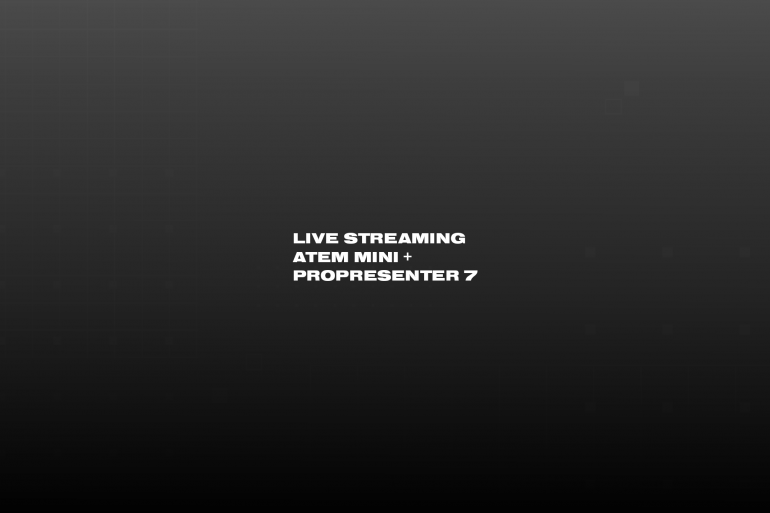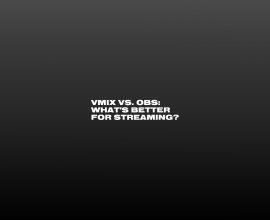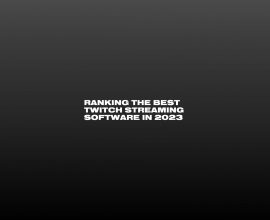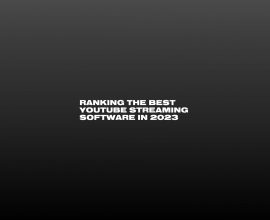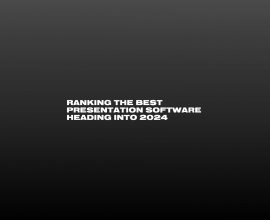Live Streaming ATEM Mini + ProPresenter 7
Video Transcription:
All right. I know many of you have been waiting for this video. Um, today we’re gonna talk about ProPresenter 7 and the eight, 10 mini switchers and how to use them together to live stream.
In our previous video, we covered a little bit about the features of the ATM mini and I have one of those in front of me. And today we’re gonna talk about just setting that up and going to pro presenter. So let’s look at the back of that, got the power cable here. Uh, and then I got USBC and that’s, what’s going to bring our video from the output of the ATM mini into our computer for pro presenter seven. Um, and then I have an H GMI out that I’m using for the multi view that I have in front of me on my computer desk. Um, I’ve got four video inputs I could be using to switch between. So if you had multiple cameras, you can switch between ’em by plugging them all in there. And then I have one input that I’m actually using myself.
And that’s the camera that you’re watching me on. Um, that ACMI input also is bringing audio in from the camera. Cause I have a microphone on top of the camera that brings audio into the, at 10 mini. You can actually bring audio into pro presenter with an audio interface, their system audio, uh, with your video input today, I’m gonna show you how to use the ATM mini to bring audio in. Since we’re talking about the a too mini first, we need to set up the actual software for the a 10 mini so that your computer can see it and bring its signal into, to the programs you’re using. So let’s go to black magic design.com/support, and then in the search by model section, we’ll go ahead and type in at 10 mini and I have the pro. So I’ll click on that. All right. So what you’re gonna need to do is make sure you have the most recent switcher update installed. That’s what’s gonna give you your desktop software that you need to run the program, um, run the hardware, and then as well as it’ll give you any firmware updates that you may need in inside of your hardware as well. So go ahead and download that, install it, and then we’ll get that opened search for ATEM. It’s called the ATEM software control
While it’s opening. One thing to note is if the switcher does not show up in here automatically, um, you may need to make sure that the firmware is updated first in order for the switcher control software to see it. Um, so to do that, you’ll wanna make sure you go to the black magic at E setup software, and then you can, uh, install the firmware there and then come back to the software control and make sure it’s set up. So in, at E software control, we’re not actually gonna do anything today because as long as the ATM mini is showing up in there and it can see it. And as long as you have that installed, um, your ATM mini can then be seen by other programs like pro presenter or zoom or Skype or OBS to be seen as a video input. All right.
So we have that installed. It’s working, it’s showing up. The next thing we’re gonna do is go to pro presenter. So we’re at the cool part now. All right, we’re gonna go ahead and set up our video and our audio inputs, and then we’re gonna make sure that they’re working, um, that you can see them in our screens and then you can live screen from there. So let’s start by going to pro presenter up on the top left we’ll click preferences, and then we’re gonna start with audio.
So in audio, by default, pro presenter comes with two channels. Um, you can, you can choose the amount of channels that you want to use there. Um, I’m gonna recommend for this setup that we go for for this example, um, and the reason being you, your two channels would be your left and your right. So if you’re sending left and a right to your in person, audience, where you’re still need gonna need left and right for your online audience, but you may not wanna send the same exact thing to both, to both audiences.
Sometimes you may wanna mute one of the other, or sometimes you, uh, may wanna change the volume of one, like the volume going to your live stream versus the volume going to your in-person audience for a video. Another great example of that is if you have copyright content that you have a license for it for in person, but you can’t show it online. Well, you can turn off the audio for it online. If you have the routing set up here. So what you’re gonna do is we’re gonna change this to four.
All right, nothing more we have to do in the audio output section. So let’s go to the input. We’re gonna go ahead and create a video input and choose my device. Black magic design, 10, a P 60. So purpose center automatically detected the signal there. Awesome. There I am. Hello. All right. And then you have the option to use audio from your video input, but, uh, the reason we’re not gonna do that is because if you had multiple video inputs and you wanted to, um, you wanted to make sure you were just using one audio source for all of them. Um, you might as well just use an audio input instead of linking that audio source on each of your videos and then which we triggering it every time. So let’s go ahead and create an audio input.
My source is gonna be again, my black magic design, um, on here, it says microphone. Um, you also have other options that’ll show up. So if you have your system audio, or if you have like, I have a focus, right. Audio interface plugged in. So I could choose that as well, but we’re gonna go ahead and choose the eight, 10 mini here. All right there, you can see my audio’s coming in from my mini, because on my mini, I have my, uh, HG I’s audio turned on. Um, and you can see it going. And, um, some, I wanna show off what these mode things are. If it says off, that means your audio’s just not gonna play. You’re not gonna be able to hear the audio going to a stream. Um, if it says on then it’s just, it’s always working. It’s always on. Um, the way that would work is if you turned on pro present and you already had an audio input selected from a previous time, it’s just gonna automatically start working again.
The other options you have are auto off. So if you have a video, that’s a foreground that you wanna play. Uh, maybe someone’s gonna talk to Mike on a stage and they’re gonna be like, alright, you can play the video now. And then they go to roll the video. Well, the thing that auto op does is it turns off your audio input while that video is playing. So that way, if the person’s burping in the mic, that that sound is not going over the video and being heard as well. Just the video is being heard when auto off is on audio on is cool because it allows you to select a specific video input for your, um, audio to be on four. So if you have, uh, multiple video inputs and you only want the audio input, this specific audio input you’re working on to show up when one of those video inputs is selected, you can choose which video input you want to work with there.
The last thing I show you here is routing by default. It’s gonna use one and two, cause that’s what the program came with was one and two. Um, but I don’t want my audio input to go to one and two, because one and two is what I’m gonna use for my in-person audience. Uh, I’m gonna use channel three and four for my online audience. So I’m gonna switch this to three and four, turn off one and two. So now I’m saying my audio input, one is gonna go to channel three and four of pro presenter. Um, and then later on in our live stream settings, we’ll choose to pull from channel three and four for our live stream. All right, that’s set up now. We don’t have to touch it again. It’s gonna be good to go. Uh, in fact, I’ll actually go ahead and just click on, on, so now my audio is working.
You can see it showing up in the meters here. All right. Next thing we’re gonna talk about is screens pro presenter comes with, um, one default screen on, so we’re gonna go to a screens and go to huge, bigger screens. Uh, you can see, I got my projector here in 1920 by 10 80. We’re just gonna pretend that we’re in a, we’re in an environment where we have one screen, just for the sake of this example, we’re in a church. We have one projector up front. That’s what we’re using to send stuff. Well, now we wanna start live streaming too. So we need a second screen. Um, this screen, isn’t gonna have a physical output. It’s not gonna go to a TV or a projector. It’s just gonna be virtualized here in the computer for our live stream to pull from. So what that means is anything we send to this new screen, that’s gonna go to our live stream, right? So we’ll go ahead and create a new audience screen. And we’re gonna create a placeholder when she’s 1920 by 10 80 personally, just so have a nice workspace to work off of. And then I’ll go ahead and call that live stream, Spell it, livestream screen, where you go spell it. Alright. Yeah, spell it over.
Cool. So that’s set up. That’s the screen. We’re gonna use to pull everything from, for our live stream. The next thing we wanna do is set up our looks. So in looks you can choose what layers you send to what screen. So we’re gonna go to screens and we’re gonna go to edit looks. Now, uh, I already have two that I built in here and I’m gonna show ’em off real quick. So if you look at lyrics, I have my video input turned off on the projector because when I’m displaying lyrics, let’s say we have a song we’re doing for church, and we want our lyrics to show up on our main screen, but we don’t want the, the live video input that we’ve just pulled into purple center to go to our main screen. We only want that on our live stream. So in here’s where you would choose, where do you want that to go?
Well, I don’t want the video input my projector, but I do want it on my live stream. So I would make sure it’s enabled on my live stream. Um, the other thing I wanna do is I wanna make sure on my live stream screen to turn off media, because media is my background and my foreground layer. I don’t want those to layer on top of my video input. And then the video input not be seen on our live stream. So that’s off, uh, slide we want on, cause we want the text to come through. And then here on this presentation section, we’re gonna actually, uh, apply an alternative theme. So what I’m gonna do is I’m gonna choose a lower third. I got a lower third theme here. So now anything, any text that is sent to my live stream screen is gonna have that lower third theme applied to it.
I don’t need to change anything on my projector’s theme here because, um, with the projector, I’m just gonna pull straight from the setup that I already have here inside a pro presenter. So anything that I have here in the, the main editor that’s, what’s gonna be seen visually on my projector. I don’t need an alternative theme for that. All right. So now that we have the lyric setup, let me make sure this pre-show section is set up with pre-show the way that that’s gonna work is, um, I’m gonna have announcements going before our, our service or our show starts. So I want, uh, we’re on images that are just constantly looping. Um, and so I’m gonna actually make sure that that’s showing up on both my live frame and my projector. I, I want that before we get to our song, before we actually start with our show, let’s say that the song is the beginning of the show.
Well, pre-show, I want my announcements to show up on our live stream. So I’m gonna make sure that the media layer, if that’s where I have my announcements running, if I have foreground images going, um, I’m gonna make sure that the media layer is enabled on both of them. And, uh, I guess I could even turn off the video input layer. So that just so that, um, if we cleared something, the video input isn’t showing through, all right. Um, and then same things you just wanna go through and check, whatever you think is gonna be. You’re gonna show on whatever screen you want to be showing on. So if you do have an announcements layer that you’re trying to show stuff off of, you’d want that enabled, um, and then your props or messages, et cetera. Cool. So now that those are working, we’ll actually go through and we’re gonna add these audience looks to a specific document.
So I want my pre-show look to trigger when I click this first welcome slide. So let’s go to add action audience, look and choose. Pre-show cool. Now, when we start the, uh, the first song here, that’s, I mean, that first song is when we’re also gonna start, uh, having a live video. So I might as well just, uh, add our live video there and our lyrics audience. Look, let’s go ahead and add the audience. Look first, right? Click add action audience, look lyrics. Now our lyrics will show through on our, our projector and, um, on our live stream, just our live video will show through since that’s what we set up on that action. Um, now down here in the video input playlist, I can go ahead and actually add in the input that we just created earlier. Now that an input is here. So currently I don’t have the input triggered.
I just have it sitting in pro presenter ready to be triggered. Um, and again, once you add in all those inputs and your preferences, you don’t have to keep doing that in the future. You just set it and you go, and it’s good to go, but you want a way to be able to switch between them, right? So you can add in all of your video inputs down here, if you had more, you could add more. I could probably, yeah, I can add more of the same one if I wanted to. Um, but I don’t need to, so I’m gonna delete that. So I have my one video input here. If I click it, it’s triggered, it’s live, but it’s not showing because I don’t have that specific look applied. That would let it show. So now if I drag it to my good grace slide here, the first song we’re doing, and if I click it, it’s now gonna make it live on our live stream.
There’s my video coming through instead of that background. But if I go back to the projector, the background is playing through instead of my video input. So the reason is, is because I have the video input triggered there as well as the audience look triggered there for my lyrics that we set up. Now, you don’t have to apply an audience, look to every slide. You just have to apply it where you want it to be able to change a look, to be able to change. What’s going to watch screens so you could apply it to the first song in your set, if you have multiple sets, um, and then same with your video input. You only need to trigger when you’re gonna, um, start it up. I could have put it on our announcements if I wanted to that way, it’s just running the whole time and we don’t have to worry about it.
I just decided to add it to our, our first song there. So that’s one option. So now that it’s running and we’ve got it on both our live stream, our projector, if I go to my lyrics and actually queue ’em up, you’ll see the lower, the thirds pop up. And that’s because we on our audience, look, we had selected that alternative theme. Right? Cool. So the next thing we’re gonna do is we’re gonna go to live up here in the top right corner, but it capture settings and then we’re gonna choose our source. Well, our source is gonna be the screens that we created. We want our source to be the live stream screen. That way it’s pulling from that screen, that we’re, we’re saying anything, that’s going to this screen. That’s, what’s gonna go to our live stream so I can go ahead. Click livestream screen.
That’s a source we’re pulling from, for our live stream. Now our destination is gonna be R TMP or REI or your disc. The differences between those are your disc. Is this just a local recording? It’s not going online. R TMP is a, is a protocol for streaming that, um, a lot of companies use for free. So Facebook and YouTube, um, some other companies that have paid options for that, as well as, as long as they give you an address key, um, you can go ahead and put those in there and you can stream straight to those destinations. Um, and then REI is option. You can use, if you want a higher quality stream, that’s gonna be resilient and reliable. Um, and then you can go ahead and let’s just choose RTP for this example. If, if I was to go live on Facebook, they would give me an address and a key I’d put ’em in here. And then Facebook currently only streams in seven 20 P, but it can accept a higher quality stream. So like I would, I would personally just set this to 10 80, 30 from my stream, um, because I wanna save a local copy as well. That way I have a high quality 10 ADP local copy here on my computer that I can edit afterwards. But Facebook is still streaming at seven 20 online and that’s okay. All right. And then the last thing we’re gonna look at here is the audio route.
So here we have our four channels showing broker channel 1, 2, 3, 4, and then you can see our output is left and right. So again, earlier we said anything going to our live stream. We want to pull from three and four, so we’re gonna choose three and four here. What that’s saying is our live stream is gonna pull from purpose air channel three and four. So we’re gonna click that now. Anything going to channel three and four will go to our live stream and our local recording. So all you have to do is click start capture, and you’re gone. You’re golden. You’re good. But then once it’s set up, you don’t have to do it again. Um, it’s set and go, your volunteers, just click through it. The only thing you may have to do is add in, add your actions or your audience looks or create new audience looks as you need them.
Um, and add them to slides. You know, if let’s say you you’re going to a new week and, and you wanna make sure your first song has a new audience look applied to it. Well, you’re just gonna have to add the action. That’s not too difficult to do ahead of time. Um, but then when you’re volunteers and your staff come in on your weekends, or whenever you’re having your event, um, it’s really easy for them to just go through there and stream straight from there. One of the biggest benefits for doing it this way, instead of, um, maybe going back into your eight to mini and then streaming from your eight to mini, is that with the eight to mini, it only has HTMI. So you can’t do alpha key, which is a higher quality key. You can only do Chrome key and Luki. You’re gonna get a much better flexibility and much better quality if you’re streaming, um, using pro presenter than the ATEM for your content for your lower third, like you’re, you’re not gonna have to key those out and have them, uh, look a little rough, pulling them in via Chrome, key and other stuff.
So if you’re layering them inside of pro presenter, it gives you a much cleaner look and a lot more flexibility. And so that, that’s why we recommend doing that. I hope this video is helpful. Um, let us know, and we can’t wait to keep helping you in, in helping you share the stories that, that changed the world.
